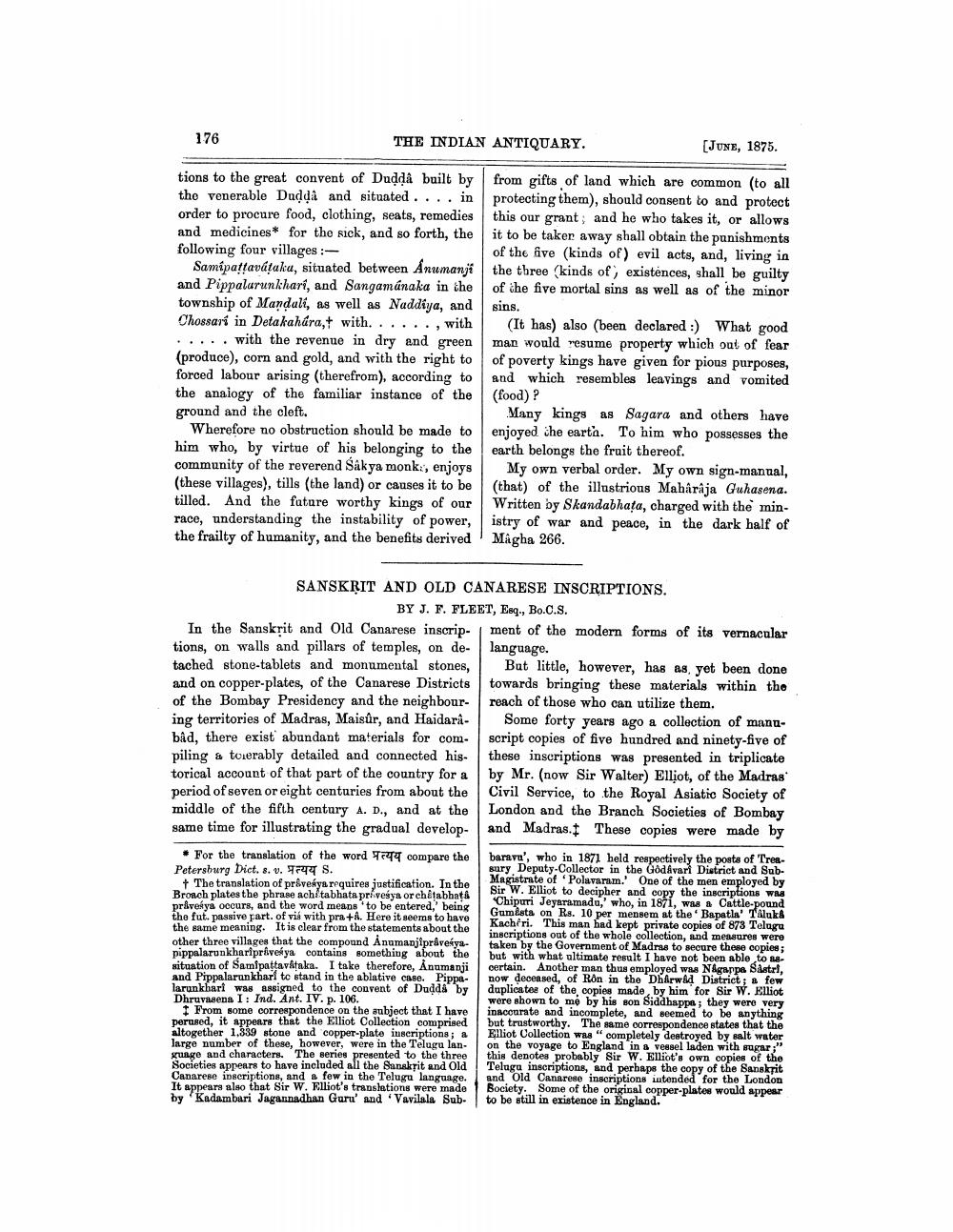________________
176
THE INDIAN ANTIQUARY.
(JUNE, 1875.
tions to the great convent of Duddå built by the venerable Dudda and situated . . . . in order to procure food, clothing, seats, remedies and medicines* for the sick, and so forth, the following four villages :
Samipattavataku, situated between Anumanji and Pippalurunkhari, and Sangamánaka in the township of Mandali, as well as Naddiya, and Chossari in Detakahára,t with... ..., with ..... with the revenue in dry and green (produce), corn and gold, and with the right to forced labour arising (therefrom), according to the analogy of the familiar instance of the ground and the cleft.
Wherefore no obstruction should be made to him who, by virtue of his belonging to the community of the reverend Sakya monk, enjoys (these villages), tills (the land) or causes it to be tilled. And the future worthy kings of our race, understanding the instability of power, the frailty of humanity, and the benefits derived
from gifts of land which are common (to all protecting them), should consent to and protect this our grant; and he who takes it, or allows it to be taken away shall obtain the punishments of the five (kinds of) evil acts, and, living in the three (kinds of existences, shall be guilty of įhe five mortal sins as well as of the minor sins.
(It has) also been declared :) What good man would resume property which out of fear of poverty kings have given for pious purposes, and which resembles leavings and vomited (food)?
Many kings as Sagara and others have enjoyed the earta. To him who possesses the earth belongs the fruit thereof.
My own verbal order. My own sign-manual, (that) of the illustrious Maharaja Guhasena. Written by Skandabhata, charged with the ministry of war and peace, in the dark half of Magha 266.
SANSKRIT AND OLD CANARESE INSCRIPTIONS.
BY J. F. FLEET, Esq., Bo.C.S. In the Sanskrit and Old Canarese inscrip- ment of the modern forms of its vernacular tions, on walls and pillars of temples, on de- language. tached stone-tablets and monumental stones, But little, however, has as, yet been done and on copper-plates, of the Canarese Districts towards bringing these materials within the of the Bombay Presidency and the neighbour reach of those who can utilize them. ing territories of Madras, Maisûr, and Haidarà Some forty years ago a collection of manubad, there exist abundant materials for com- script copies of five hundred and ninety-five of piling a touerably detailed and connected his- these inscriptions was presented in triplicate torical account of that part of the country for a by Mr. (now Sir Walter) Elliot, of the Madras period of seven or eight centuries from about the Civil Service, to the Royal Asiatic Society of middle of the fifth century A. D., and at the London and the Branch Societies of Bombay same time for illustrating the gradual develop- and Madras. These copies were made by
snade
hond copy the men ettpad Sub
Kachlo
• For the translation of the word 7 4 compare the Petersburg Dict. 8. v. 97744 S.
+ The translation of prvekya requires justification. In the Bronch plates the phrase achitabhata prívesya or chitabhatá právekya occurs, and the word means to be entered, being the fut. passive fart. of vis with pra +å. Here it seems to have the same meaning. It is clear from the statements about the other three villages that the compound Anumanjipraveyapippalarunkhariprive ya contains something about the situation of Samipattavktaka. I take therefore, Anumanji And Pippalarunkhari to stand in the ablative case. Pippalarunkhart was assigned to the convent of Dudds by Dhruvasena I: Ind. Ant. IV. p. 106.
From some correspondence on the aubject that I have perused, it appears that the Elliot Collection comprised altogether 1,339 stone and copper-plate inscriptions; a large number of these, however, were in the Telugu language and characters. The series presented to the three Societies aprerrs to have included all the Sanskrit and Old Canarese inscriptions, and a few in the Telugu language. It appears also that Sir W. Elliot's translations were made by Kadambari Jagannadhan Guru' and 'Vavilala Sub-
baravu', who in 1871 beld respectively the posts of Tros. sury Deputy Collector in the Godavari District and SubMagistrate of Polavaram.' One of the men employed by Sir W. Elliot to decipher and copy the inscriptions was
Chipuri Jeyaramada,' who, in 1871, was a Cattle-pound Gumlata on Rs. 10 per mensem at the Bapatla' Taluka Kachiri. This man had kept private copies of 873 Telugu inscriptions out of the whole collection, and measures were taken by the Government of Madras to secure these copies but with what ultimate result I have not been able to a certain. Another man thus employed was Nagappa Sastri, now deceased, of Rôn in the Dharwd District ; & few duplicates of the copies made by him for Sir W. Elliot were shown to me by his son Siddhappe; they were very inaccurate and incomplete, and seemed to be anything but trustworthy. The same correspondence states that the Elliot Collection was "completely destroyed by salt water on the voyage to England in a vessel laden with sugar;" this denotes probably Sir W. Elliot's own copies of the Telugu inscriptions, and perhaps the copy of the Sanskrit and Old Canarese inscriptions intended for the London Bociety. Some of the origical copper-plates would appear to be still in existence in England.




